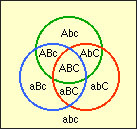John Venn (1834-1923)
British logician, known for the famous "Venn diagram". He was first interested in theology (his father was an evangelical divine), but influenced by such agnostics as Henry Sidgwick in Cambridge, and by reading Boole's or de Morgan's works on logic, he became a logician.
As regards the traditional syllogism, he proposed the "existential" view that the four categorical forms of proposition are concerned with the existence or non-existence of a kind; and he propounded the view that universal poropositions do not have the "existential import" (that is, the view that a universal proposition does not imply any existential proposition). Thus, the Aristotelian syllogism on this view can be interpreted in terms of emptiness or nonemptiness of eight compartments marked out by three terms.
Venn Diagram with 8 compartments
Like many other logicians in the 19th century, he is also known for his work in probability theory. He is usually referred to as one of the founders of the frequency theory of probability, which interprets probability in terms of the long-run relative frequency of an event. He propounded this view in his Logic of Chance (1866, 3rd ed., 1888); but according to Sandy Zabell's recent study, Venn's view changed through the revision of this book, and he came closer to the "degree-of-belief" view, although he did not abandon the frequentist view.
Å@
